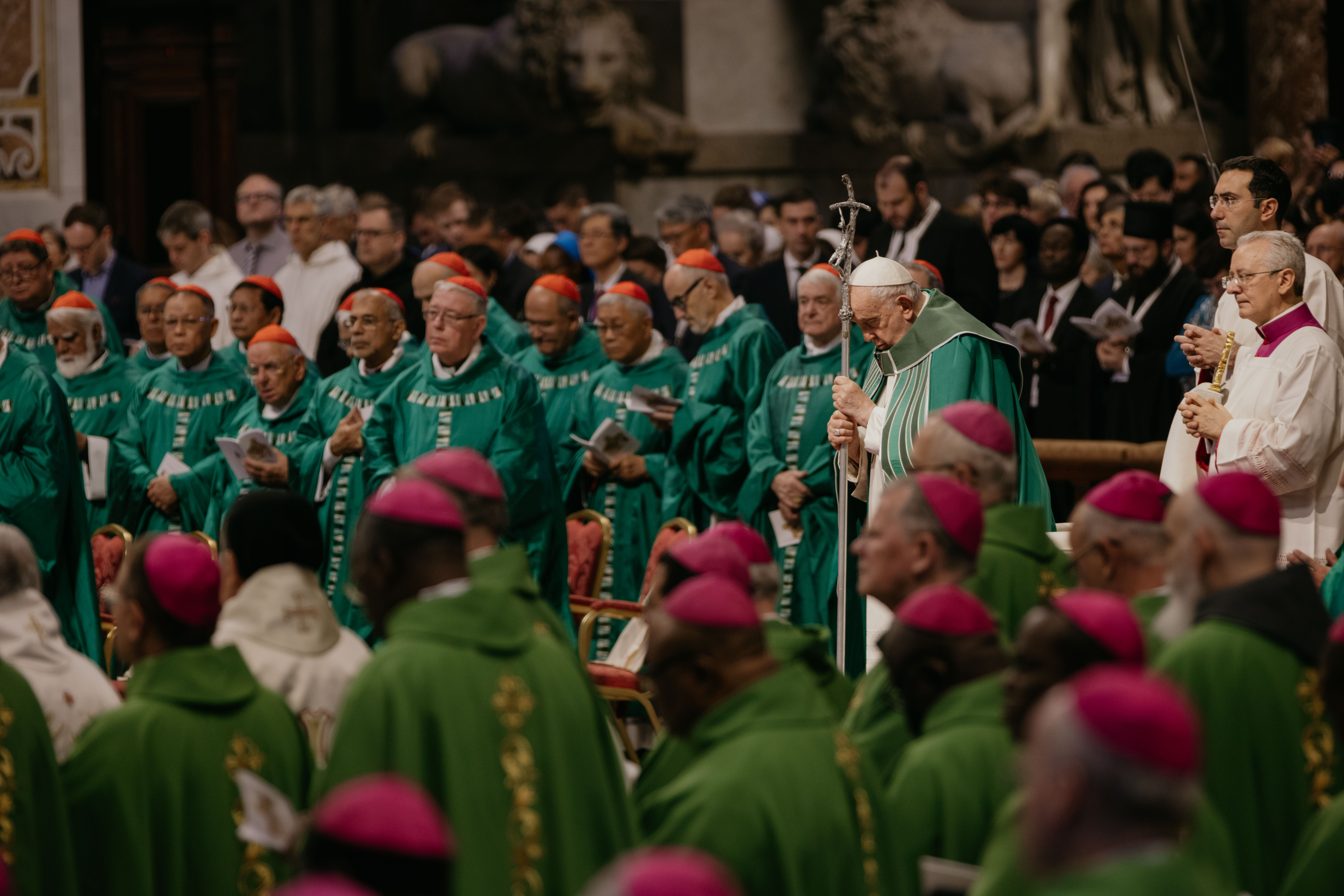The First General Session of the Synod of Bishops “For a Synodal Church: Communion, Participation, and Mission” has concluded. On October 28, the voting members of the synod voted—paragraph by paragraph—on a synthesis (or summary) report, written in Italian, with the title (in translation) of “A Synodal Church on Mission.” (Pro tip: some web browsers will allow you to generate an automatic—albeit poor— translation into English.) As Courtney Mares reports, “The 42-page text covers 20 topics from ‘the Dignity of Women’ to ‘the Bishop of Rome in the College of Bishops.’ For each topic, ‘convergences,’ ‘matters for consideration,’ and ‘proposals’ are outlined.”1
The nature of this document should be explained. It is not a magisterial text with any teaching authority. Neither is it a juridical document implementing any changes to canon law or Church governance. It is merely a document summarizing the results of the conversations that took place during the assembly’s small-group and plenary sessions. This text is an interim document, since the synod is not completely over. “This report will go back to local churches around the world for further consideration and input for the next phase of the synodal process and the next session in Rome in Oct. 2024,” notes Cindy Wooden.2 As Jonathan Liedl observes, “Although the synthesis document is not a final synodal report that will be presented to the pope, it is widely seen as a critical point of inflection, setting the stage for the final step of the Synod on Synodality.”3 In other words, it is a springboard for further discernment and discussions.
After all, we do not need a final report from the synod before advocating for orthodoxy and outreach to those in need in our own parishes and dioceses.
The finalization of the document was not without its challenges. “A draft text, a copy of which was obtained by The Pillar, reportedly prompted more than 1,000 requests for amendments,”4 writes Luke Coppen. This fact is not surprising; it was already obvious from earlier reports that the synod membership was divided on key, controversial questions. As a result, “absent from the summary report are definitive conclusions on same-sex blessings, women’s ordination, and a handful of other hot-button topics that have drawn the lion’s share of media attention during this year’s assembly,”5 notes Courtney Mares.
With respect to women and the diaconate, the document acknowledges the continued divergence on this issue.
Different positions have been expressed regarding the access of women to the diaconal ministry. Some consider that this step would be unacceptable as it is discontinuous with Tradition. For others, however, granting women access to the diaconate would restore a Church practice of the early Church. Still others discern in this passage an appropriate and necessary response to the signs of the times, faithful to Tradition and able to find an echo in the hearts of many who seek a renewed vitality and energy in the Church. Some express the fear that this request will be an expression of a dangerous anthropological confusion, which by accepting the Church would align itself with the spirit of the time.
Interestingly, Pope Francis addressed this issue himself apart from the synod. Despite the speculation by many commentators that Pope Francis would seek to change the Church’s practice on women’s ordination, he has insisted on the contrary. As Hannah Brockhaus relates, “Pope Francis reaffirmed the impossibility of women becoming priests, or even modern Church deacons, in an interview for a book released Tuesday in Italy. The question of whether some women in the early Church were ‘deaconesses’ or another kind of collaborator with the bishops is ‘not relevant, because holy orders is reserved for men,’ the pope said.”6
For those in the know, this is not a surprise given that back on June 1, 2021, Pope Francis revised the Code of Canon Law, strengthening the current position by adding a penalty both to bishops who try to ordain women to any level of holy orders as well as to any woman who attempts to receive such holy orders. Canon 1379 §3 reads: “Both a person who attempts to confer a sacred order on a woman, and the woman who attempts to receive the sacred order, incur a latae senteniae excommunication reserved to the Apostolic See; a cleric, moreover, may be punished by dismissal from the clerical state.”7 Sometimes called an ‘automatic excommunication,’ latae sententiae excommunication basically means that one is excommunicated by the very fact of having committed the offense. In other words, no trial or other legal process is needed for it to take effect. Reserved to the Apostolic See means that only the Vatican, under the pope’s authority, can remove the penalty. If these facts are any indication, those who persist in their insistence on ordaining women to the diaconate will be sorely disappointed when the synodal process concludes next year.

Other items, however, are still to be decided. In fact, the main theme of this synod, synodality itself, has still been left somewhat indeterminate. While offering some working definitions of synodality, “the text noted a need to ‘clarify the meaning of synodality at different levels,’” “called for an ‘in-depth terminological and conceptual study of the notion and practice of synodality,’” and “said that a ‘special intercontinental commission of theologians and canonists’ should examine synodality’s canonical implications.”8 Thus, after two years of conversations on the local, diocesan, regional, and universal Church levels, the very meaning and practical implications of synodality are still unclear.
Obviously, then, there is still a lot to be done over the course of the next year. The speculations and commentaries will continue to abound, I am sure. As with the process thus far, I recommend taking a balanced, cool-headed approach. The temptation to grandiose predictions and doomsday-prophecies is strong, but rarely do they come to pass. It is more prudent to focus on doing what we can: pray and get involved in the Church according to our circumstances and capabilities. After all, we do not need a final report from the synod before advocating for orthodoxy and outreach to those in need in our own parishes and dioceses.
You can read part 6 here, part 5 here, part 4 here, part 3 here, part 2 here, and part 1 here.
1 Courtney Mares/CNA, “Vatican Releases Synod on Synodality Report Proposing Larger Role for Laity in Church,” National Catholic Register (Oct. 28, 2024).
2 Cindy Wooden, “Synod synthesis shows agreement, divergences, including on ‘synodality,’” United States Conference of Catholic Bishops (Oct. 28, 2023).
3 Jonathan Liedl/CNA, “Synod on Synodality: Anticipation and tension brew ahead of synthesis report release,” The Catholic World Report (Oct. 27, 2023).
4 Coppen, “Synod report proposes ways to foster synodal Church,” The Pillar (Oct. 28, 2023).
5 Courtney Mares/CNA, “Vatican Releases.”
6 Hannah Brockhaus, “Pope Francis on women deacons: ‘Holy orders is reserved for men,” Catholic News Agency (Oct. 25, 2023).
7 Code of Canon Law, c. 1379, §3, in The Code of Canon Law, available online here.
8 Coppen, “Synod report.”
